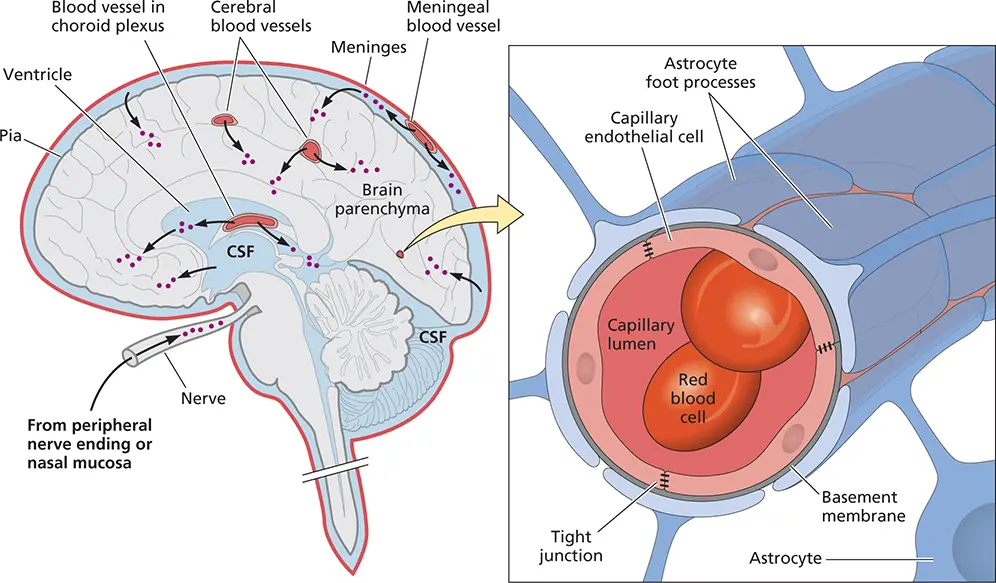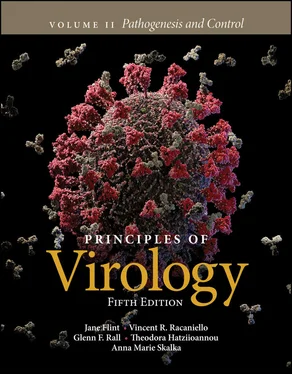S. Jane Flint - Principles of Virology, Volume 2
Здесь есть возможность читать онлайн «S. Jane Flint - Principles of Virology, Volume 2» — ознакомительный отрывок электронной книги совершенно бесплатно, а после прочтения отрывка купить полную версию. В некоторых случаях можно слушать аудио, скачать через торрент в формате fb2 и присутствует краткое содержание. Жанр: unrecognised, на английском языке. Описание произведения, (предисловие) а так же отзывы посетителей доступны на портале библиотеки ЛибКат.
- Название:Principles of Virology, Volume 2
- Автор:
- Жанр:
- Год:неизвестен
- ISBN:нет данных
- Рейтинг книги:3 / 5. Голосов: 1
-
Избранное:Добавить в избранное
- Отзывы:
-
Ваша оценка:
- 60
- 1
- 2
- 3
- 4
- 5
Principles of Virology, Volume 2: краткое содержание, описание и аннотация
Предлагаем к чтению аннотацию, описание, краткое содержание или предисловие (зависит от того, что написал сам автор книги «Principles of Virology, Volume 2»). Если вы не нашли необходимую информацию о книге — напишите в комментариях, мы постараемся отыскать её.
Volume I: Molecular Biology
Volume II: Pathogenesis and Control
Principles of Virology, Fifth Edition
Principles of Virology, Volume 2 — читать онлайн ознакомительный отрывок
Ниже представлен текст книги, разбитый по страницам. Система сохранения места последней прочитанной страницы, позволяет с удобством читать онлайн бесплатно книгу «Principles of Virology, Volume 2», без необходимости каждый раз заново искать на чём Вы остановились. Поставьте закладку, и сможете в любой момент перейти на страницу, на которой закончили чтение.
Интервал:
Закладка:
Rashes are not restricted to the skin. Lesions may also occur in mucosal tissues, such as those in the mouth and throat. Because these surfaces are wet, vesicles break down more rapidly than on the skin. During measles infection, ulcerating vesicles in the mouth, called Koplik spots, appear 2 to 4 days before the characteristic skin lesions. Identifying a viral infection early has obvious containment benefits: by the time that the infection is recognized from the skin rash, viral transmission to other individuals may already have occurred.

Figure 2.21 How viruses gain access to the central nervous system. (Left) A summary of the mechanisms by which viruses can enter the brain is shown. CSF, cerebrospinal fluid. (Right )Schematic of the composition of the blood-brain barrier.
Shedding of Virus Particles
Viruses that cannot spread from host to host face extinction. Just as there are many ways that viruses can infect host species, there are even more ways for them to get out. The release of virus particles from an infected host is called shedding. While most transmission events are attributable to such release, there are some exceptions. These exceptions include vertical transmission of integrated viral genomes in the host germ line from mother to child, and transmission via blood transfusions or organ transplantation, such as can occur with human immunodeficiency virus type 1 and hepatitis viruses.
During localized infections in or near one of the body openings, shedding can occur from the primary site of virus reproduction. The papillomaviruses cause genital warts; these viruses reproduce locally in the genital epithelium and are transmitted to hosts via sexual contact. In contrast, virus particles that result in disseminated infections can exit the host from many sites. Effective transmission of virus particles from one host to another depends on the concentration of released particles and the mechanisms by which the virus particles are introduced into the next host. The shedding of small quantities of virions may be insufficient to cause new infections, while the shedding of high concentrations may facilitate transmission via minute quantities of tissue or body fluid. For example, the concentration of hepatitis B virus particles in blood can be so high that a few microliters is sufficient to initiate an infection. Similarly, when you receive a mosquito “bite” (actually a sting), a tiny amount (less than a microliter) of its saliva is injected, which may contain sufficient particles to result in widespread infection. An interesting feature of such infections is that the mosquito saliva also numbs the site, stops the blood from clotting, and induces inflammation, which can help to spread the infection.
Respiratory Secretions
Respiratory transmission depends on the density of virus particles in the secretion, and the duration of a liquid droplet in the air. Aerosols are produced during speaking and normal breathing, while coughing produces even more forceful expulsion. Transmission from the nasal cavity is facilitated by sneezing and is much more effective if infection induces the production of nasal secretions. A sneeze from an influenza virus-infected individual produces up to 20,000 droplets (in contrast to several hundred expelled by coughing), although a recent publication assessing influenza virus transmission found almost no virus in a “sneeze vapor”; virtually all infectious virus was found in the liquids expelled during a cough. As noted when we discussed viral entry, the size of a droplet affects its “hang time”: large droplets fall to the ground, but smaller droplets (1 to 4 μm in diameter) may remain suspended in the air for many hours. Such particles may not only come in contact with a naïve host but also penetrate into the lower respiratory tract. Nasal and oral secretions also frequently contaminate hands or tissues. The infection may be transmitted when these objects contact another person’s fingers, and that person in turn touches his or her nose or conjunctiva. In today’s crowded society, the physical proximity of people may select for viruses that spread efficiently by this route. Sneezing and coughing may be the body’s way of trying to eliminate an irritant in the respiratory tract. While it is appealing to speculate that viruses may have been selected that induce thunderous noises and ejection of alarming volumes of body fluids to ensure transmission to new hosts, this hypothesis has not yet been proven ( Box 2.12).
Saliva
Some viruses that reproduce in the lungs, nasal mucosa, or salivary glands are shed into the oral cavity. Transmission may occur through aerosols, as discussed above, via contaminated fingers, or by kissing or spitting. Animals that lick, nibble, and groom may also transmit infections in saliva. Perhaps the best-known human virus that is transmitted in this way is Epstein-Barr virus, which results in mononucleosis, often called “kissing disease.” Remarkably, the incubation time for this virus (that is, the time between infection and disease) is 4 to 7 weeks. Consequently, an Epstein-Barr virus-infected Lothario has lots of time to transmit far more than a radiant smile and magnetic personality before being “found out.” Human cytomegalovirus, mumps virus, and some retroviruses can also be transmitted by means of saliva exchange.
Feces
Particles of enteric and hepatic viruses that are shed into the intestine and transmitted via a fecal route are generally more resistant to inactivation by environmental conditions than those released at other sites. Viruses transmitted by fecal spread usually survive dilution in water, as well as drying. An important exception is hepatitis B virus, which is shed in bile that is released into the intestine, but is inactivated as a consequence and therefore not transmitted in feces.
Inefficient sewage treatment or its absence, contaminated irrigation systems, and the use of animal manures are prime sources of fecal contamination of food, water supplies, and living areas. Any one of these conditions provides an effective mode for continual reentry of these viruses into the alimentary canals of new hosts, the so-called “fecal-oral route.” Two hundred years ago, such contamination was inevitable in most of the world, as disposal of human feces in the streets was a common practice. Communities downstream of sites of defecation and waste removal used contaminated water for cooking and drinking. With modern sanitation, the fecal-oral cycle has been largely interrupted in developed countries, but it remains a major cause of viral spread throughout the rest of the world.
BOX 2.12
DISCUSSION
A ferret model of influenza virus infection ignites irrational fears
Ferrets, which are carnivorous mammals, are excellent models for the study of influenza virus infection, pathogenesis, and transmission. Human and avian influenza viruses reproduce in the ferret airway, and infected animals develop many characteristic signs of the flu, including fever and sneezing. The release of infectious virus through nasal discharges allows for ferret-to-ferret transmission of influenza, an observation first reported in 1933.
In 2011, influenza virus experiments using this well-established model came under intense media scrutiny when two research groups genetically engineered an H5N1 strain of influenza virus that was suspected to have pandemic potential in humans. These investigators showed that the engineered viruses were transmissible in ferrets, raising concerns that, if the viruses or an infected ferret escaped or was otherwise released, a new influenza pandemic could be triggered. The debate, which continues to impact the scientific and lay communities, centers around “dual-use” experiments: studies that have both a potential public health benefit but that could also be used for bioterrorism or could endanger humans. Some scientists have contended that work such as this should never have been done, given the risks. Others, including many virologists, counter with multiple points. First, that a virus can be transmitted in ferrets does not indicate that it will also spread in humans. However, knowing the genetic changes that affect transmission would have great benefit should an H5N1 virus infection occur in humans. Moreover, high-level biocontainment facilities and procedures for performing such experiments safely are in place to prevent accidental release of nefarious viruses (or infected animals). While it may seem like the basis of an exciting thriller, work with these agents is strictly controlled.
Читать дальшеИнтервал:
Закладка:
Похожие книги на «Principles of Virology, Volume 2»
Представляем Вашему вниманию похожие книги на «Principles of Virology, Volume 2» списком для выбора. Мы отобрали схожую по названию и смыслу литературу в надежде предоставить читателям больше вариантов отыскать новые, интересные, ещё непрочитанные произведения.
Обсуждение, отзывы о книге «Principles of Virology, Volume 2» и просто собственные мнения читателей. Оставьте ваши комментарии, напишите, что Вы думаете о произведении, его смысле или главных героях. Укажите что конкретно понравилось, а что нет, и почему Вы так считаете.



